Small populations of Stone Age people drove dwarf hippos and elephants to extinction on Cyprus
Today's routine refutation of creationism comes in the form of an article about the pygmy fauna on the Mediterranean island of Cyprus, that, along with similar pygmy fauna on other Mediterranean islands, was probably exterminated by early modern humans 3,000 - 4,000 years before the mythical 'Creation Week'.
The article is by Corey J. A. Bradshaw, Matthew Flinders Professor of Global Ecology and Node Leader in the ARC Centre of Excellence for Indigenous and Environmental Histories and Futures, Flinders University; Christian Reepmeyer, Deputy Director - Oceania, Deutsches Archäologisches Institut - German Archaeological Institute, and Theodora Moutsiou, Special Scientist, University of Cyprus, published in The Conversation. It is reprinted here under a Creative Commons licence, reformatted for stylistic consistency.
But first a little background to the Mediterranean island pygmy fauna:
What can you tell me about pygmy elephants and hippos on Mediterranean Islands? Pygmy elephants and pygmy hippos were part of an intriguing group of dwarf species that once roamed the Mediterranean islands during the Pleistocene epoch. These animals evolved through a process called insular dwarfism, where species become significantly smaller than their mainland relatives due to isolated environments and limited resources on islands.
Pygmy Elephants
Several species of pygmy elephants lived on Mediterranean islands, including Crete, Sicily, Cyprus, and Malta. The phenomenon occurred when large mainland elephants swam to these islands or were otherwise isolated, and over time, the scarcity of food and the lack of large predators favored smaller, more energy-efficient sizes.
Some notable examples include:
- Palaeoloxodon falconeri, from Sicily and Malta, was among the smallest species, standing just about 1 meter (3.3 feet) tall at the shoulder.
- Palaeoloxodon cypriotes, a pygmy species on Cyprus, was similarly small.
- Palaeoloxodon creticus, from Crete, stood just around 1 meter tall and is believed to have evolved from larger straight-tusked elephants.
Despite their reduced size, these pygmy elephants retained many of the traits of their larger ancestors.
Pygmy Hippos
Like the elephants, pygmy hippos also evolved through insular dwarfism. Pygmy hippopotamuses lived on Mediterranean islands like Crete, Malta, and Cyprus. The best-known species is the Cretan pygmy hippopotamus (Hippopotamus creutzburgi).
These animals were much smaller than their mainland relatives, such as the modern common hippopotamus (Hippopotamus amphibius). For instance:
- The Cretan pygmy hippo was about the size of a domestic pig, standing around 1 meter (3.3 feet) tall at the shoulder.
While both pygmy elephants and hippos disappeared thousands of years ago, likely due to human activities and changing environmental conditions, their fossils provide fascinating insights into how species adapt to insular environments.
The study of these species helps us understand the effects of island isolation and the evolutionary pressures that can lead to remarkable changes in size and behavior.

Small populations of Stone Age people drove dwarf hippos and elephants to extinction on Cyprus
The dwarf hippos of Cyprus were around the same size as modern pygmy hippos in West Africa
Corey J. A. Bradshaw, Flinders University; Christian Reepmeyer, Deutsches Archäologisches Institut - German Archaeological Institute, and Theodora Moutsiou, University of CyprusImagine growing up beside the eastern Mediterranean Sea 14,000 years ago. You’re an accomplished sailor of the small watercraft you and your fellow villagers make, and you live off both the sea and the land.
But times have been difficult — there just isn’t the same amount of game or fish around as when you were a child. Maybe it’s time to look elsewhere for food.
Now imagine going farther than ever before in your little boat, accompanied maybe by a few others, when suddenly you spot something on the horizon. Is that an island?
An island of tiny elephants and hippos
Welcome to Cyprus as the world emerges from the last ice age. You are the first human to set your eyes on this huge, heavily forested island teeming with food.
When you beach your boat to have a look around, you can’t believe what you’re seeing — tiny boar-sized hippos and horse-sized elephants that look like babies to your eyes. There are so many of them, and you’re hungry after the long journey.
The diminutive beasts don’t seem to show any fear. You easily kill a few and preserve the meat as best you can for the long journey back.
When you get home, you are excited to let everyone in the village know what you’ve found. Soon enough, you organise a major expedition back to the island.
Of course, we’ll never know if this kind of scenario took place, but it’s a plausible story of how and when the first humans managed to get to Cyprus. It also illustrates how they might have quickly brought about the demise of the tiny hippopotamus Phanourios minor, as well as the dwarf elephant Palaeoloxodon cypriotes.
Dwarf ‘giants’
Cyprus wasn’t the only Mediterranean island with dwarf wildlife. In fact, Crete, Malta, Sicily, Sardinia and many other islands had their own dwarf elephants and hippos.
Created with Datawrapper
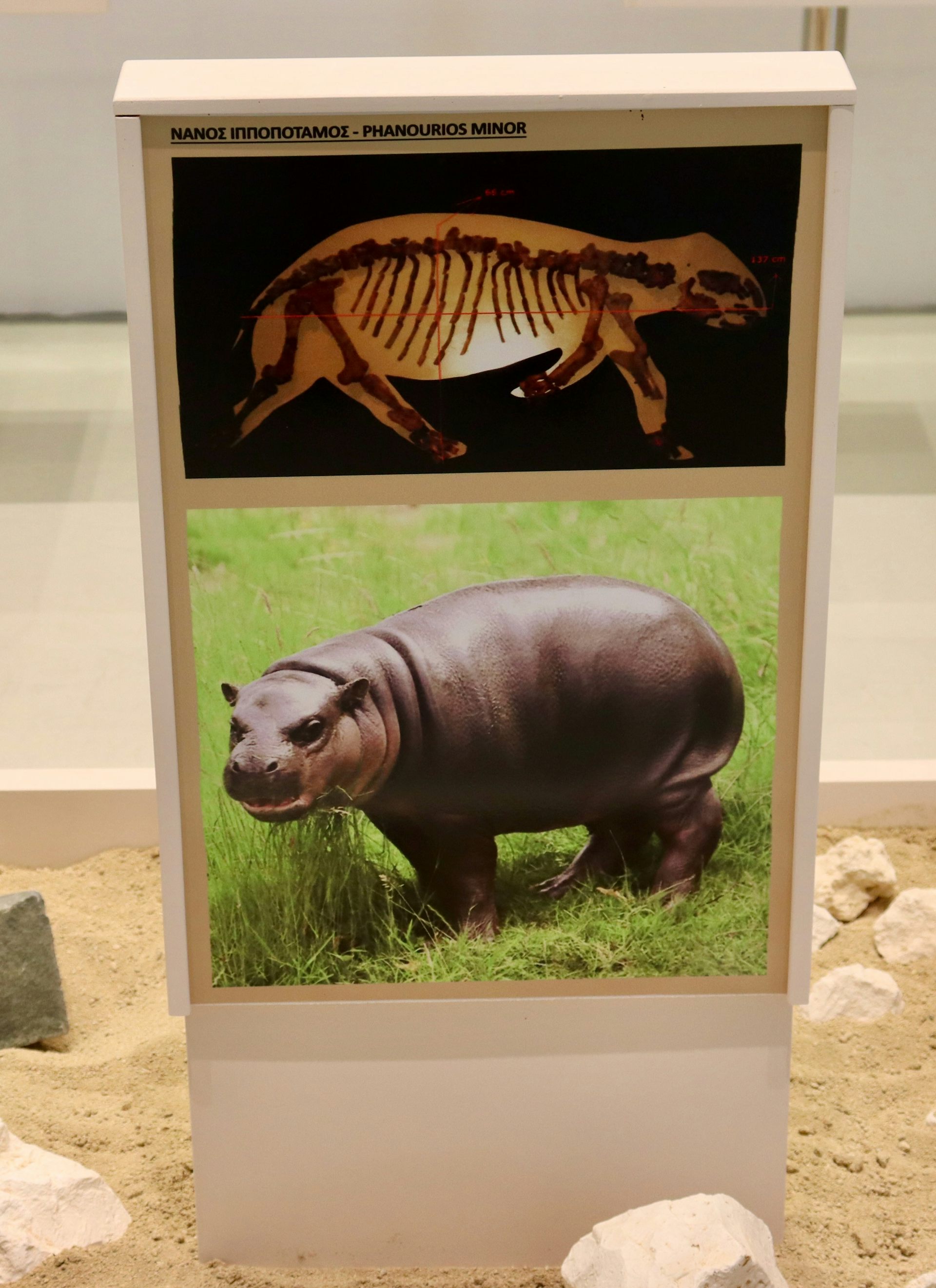
Skeleton of a dwarf hippo (Phanourios minor) and artist’s reconstruction of the animal displayed at the Akamas Geology and Palaeontology Information Centre in Pano Arodes, western Cyprus.
The Cypriot dwarf hippopotamus was the smallest dwarf hippo in the Mediterranean region. Genetic data suggest it diverged from the common hippopotamus (Hippopotamus amphibius) roughly 1.5 million years ago.
The Cypriot dwarf elephant was less than 10% of the size of its mainland ancestor, the straight-tusked elephant (Palaeoloxodon antiquus) that inhabited Europe and Western Asia during the Middle and Late Pleistocene.
An extinction controversy
For a long time, many archaeologists and palaeontologists didn’t believe humans had anything to do with the extinction of these two “megafauna” species on Cyprus.
The doubters assumed that either people arrived well after the extinctions, or the earliest humans were too few to be able to kill off entire species.
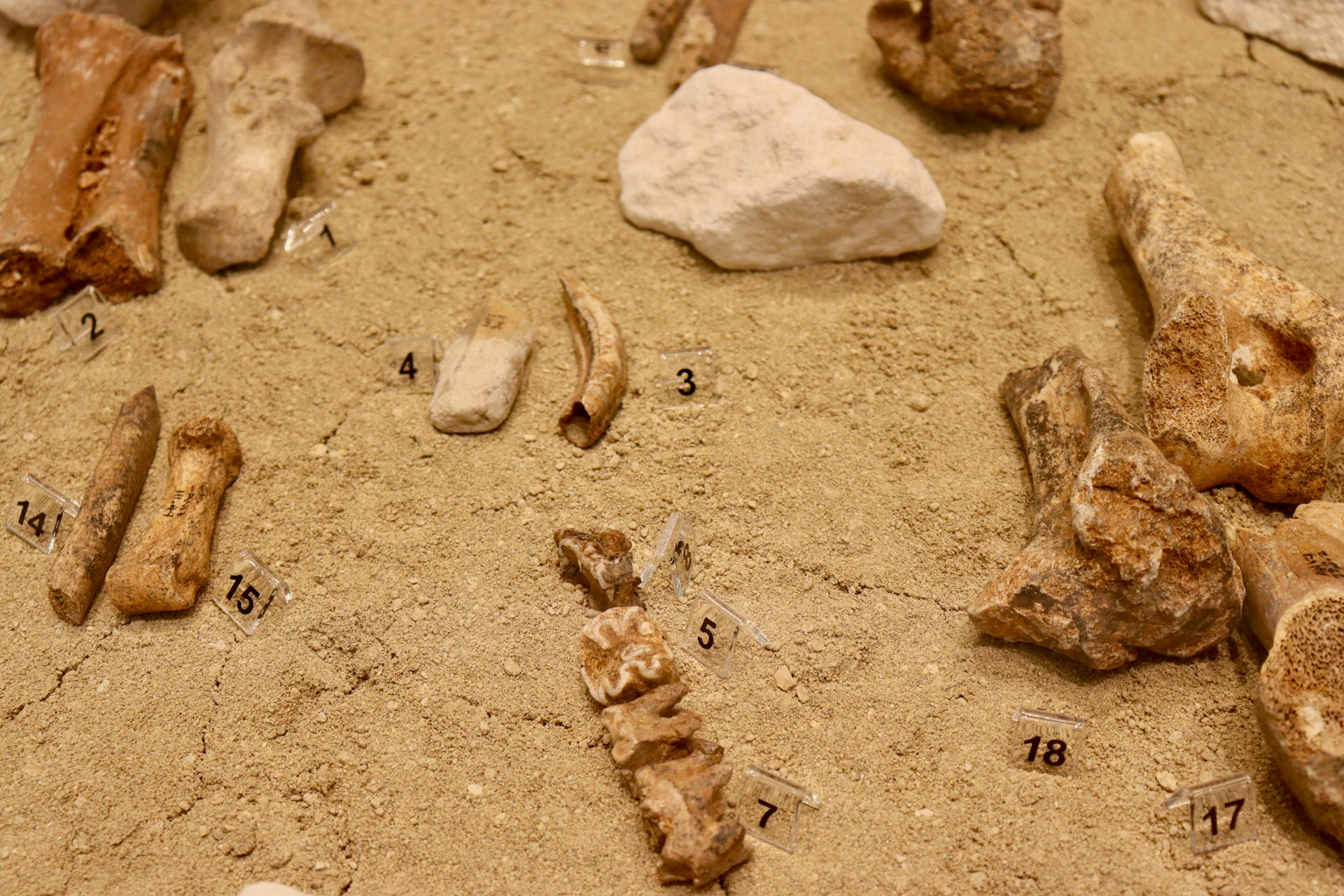
Teeth and bones of dwarf elephants (Palaeoloxodon cypriotes) displayed at the Akamas Geology and Palaeontology Information Centre in Cyprus.
CJA Bradshaw/Flinders University
Our new research published today answers this question with a combination of several different types of mathematical models.
Could a small human population cause extinction?
Even though these animals are long extinct, we can draw some conclusions about their likely population because we can estimate their weights from palaeontological information. The dwarf hippo weighed around 130kg, and the dwarf elephant came in at just over 500kg.
We also know how to translate weights to estimates of population size, longevity, survival and fertility. We can even use data collected from related species still living today, such as the pygmy hippo and the African elephant, to estimate how fast they would have grown.
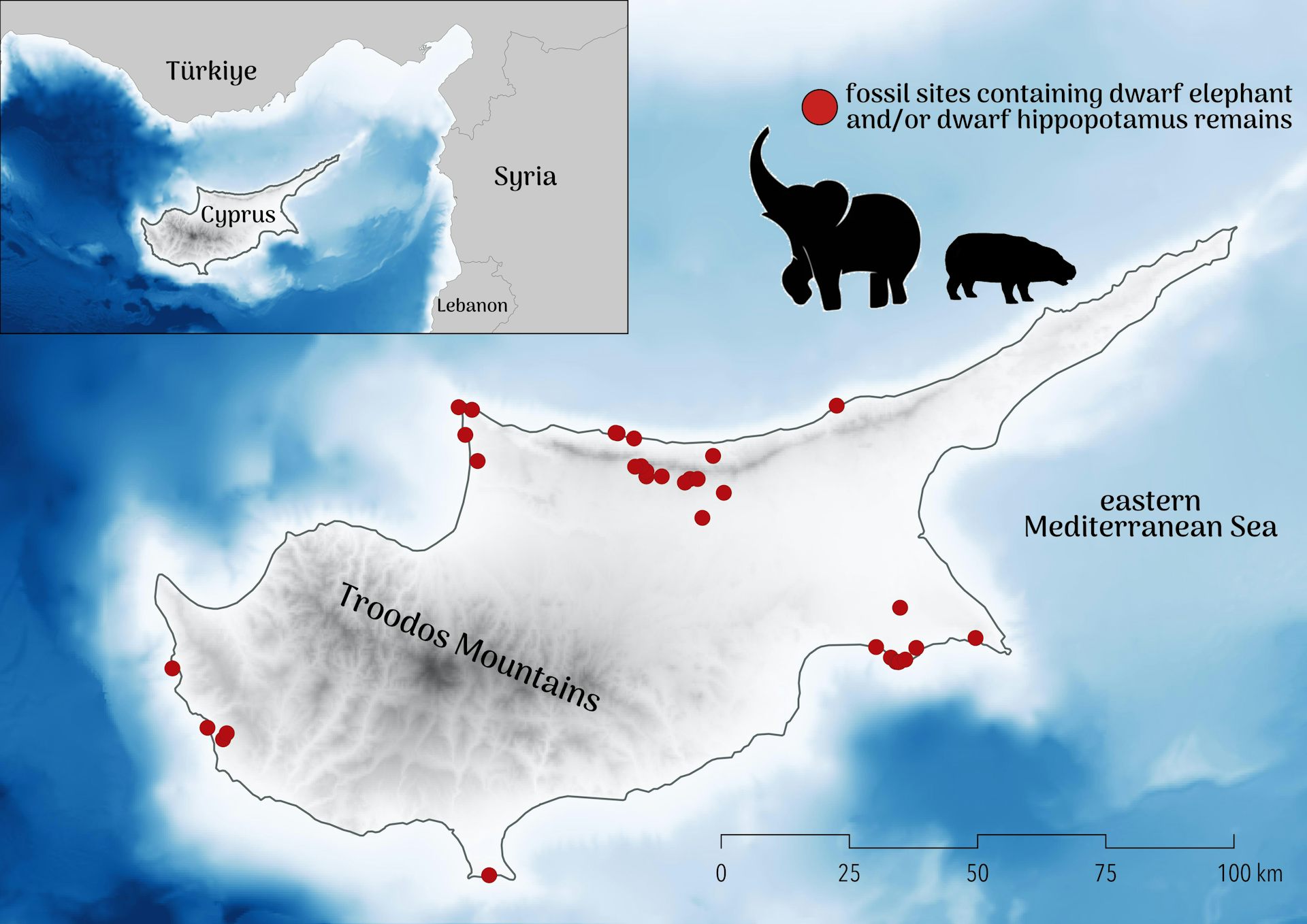
Map of Cyprus showing the approximate position of fossil sites where dwarf elephants and hippos have been retrieved.
Map created by CJA Bradshaw/Flinders University
We also estimated how much of the human diet included these species, and how this proportion might have changed as the dwarf hippo and elephant numbers dwindled.
We found that even a small human population, numbering between 3,000 and 7,000, could have easily driven first dwarf hippos, and then dwarf elephants, to extinction. Our model showed the process would have taken less than 1,000 years. This prediction matches the sequence of extinction inferred from the palaeontological record.
Our results provide strong evidence that palaeolithic peoples in Cyprus were at least partially, if not entirely, responsible for megafauna extinctions during the Late Pleistocene and early Holocene.
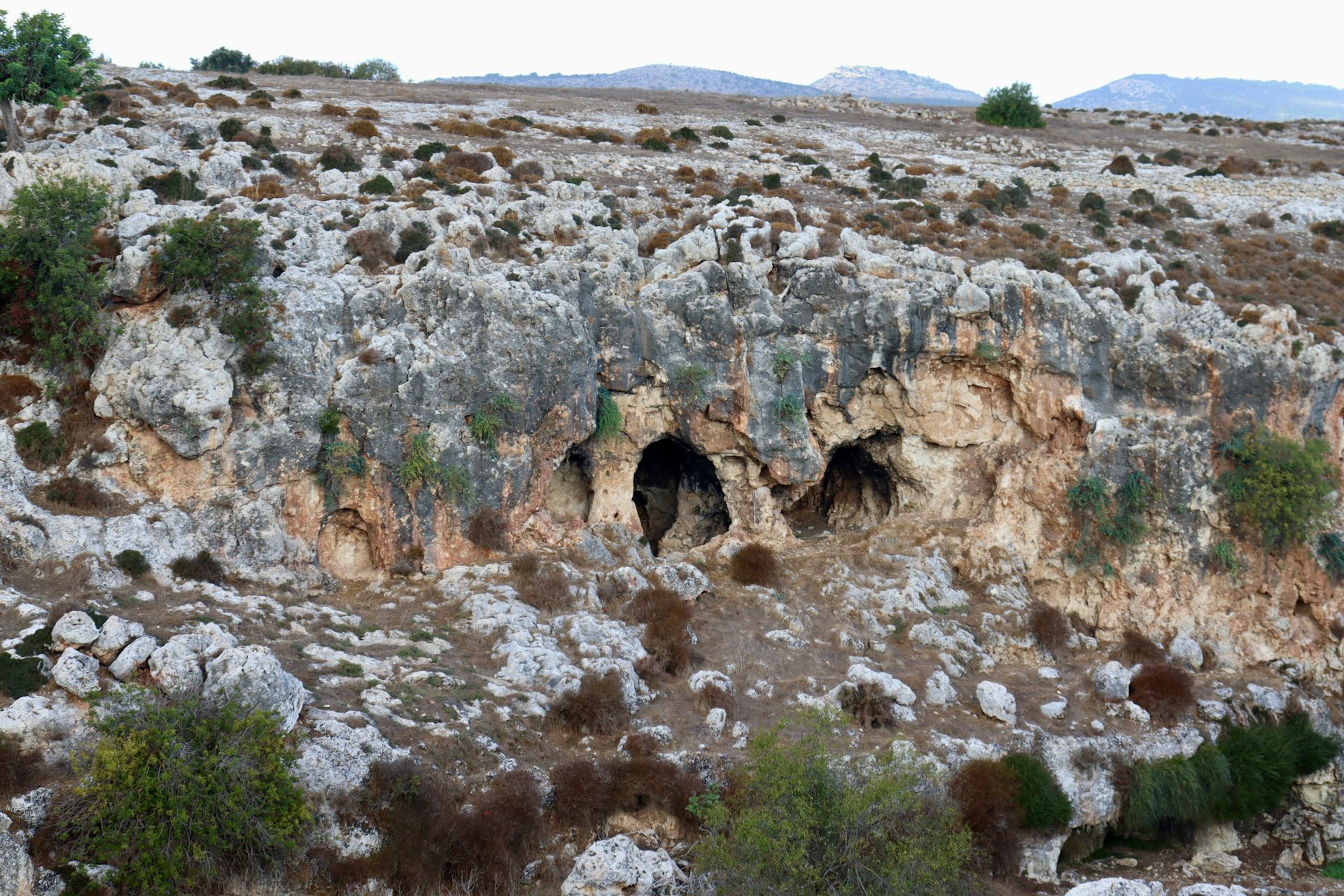
Limestone caves like the ones here are often where megafauna fossil remains are found in Cyprus.
CJA Bradshaw / Flinders University
Our research therefore improves our understanding of how even small human populations can disrupt ecosystems and cause major extinctions, particularly in times of rapid environmental change.
This article is republished from The Conversation under a Creative Commons license. Read the original article.
AbstractNot only had these pygmy hippos had about 1.5 million years to evolve away from their common ancestor with Hippopotamus amphibius, and the pygmy elephant rather less (between about 780,000 and 40,000 years) to diversify from Palaeoloxodon antiquus, or straight-tusked elephant that lived in southern Europe between 781,000 and 30-40,000 years ago, but the people who probably exterminated them had had time to reach Cyprus by about 13-14,000 years ago. And all this happened before creationist mythology says there was an Earth with living organisms on it, like 99.9975% of the rest of Earth's history.
The hypothesized main drivers of megafauna extinctions in the late Quaternary have wavered between over-exploitation by humans and environmental change, with recent investigations demonstrating more nuanced synergies between these drivers depending on taxon, spatial scale, and region. However, most studies still rely on comparing archaeologically based chronologies of timing of initial human arrival into naïve ecosystems and palaeontologically inferred dates of megafauna extinctions. Conclusions arising from comparing chronologies also depend on the reliability of dated evidence, dating uncertainties, and correcting for the low probability of preservation (Signor–Lipps effect). While some models have been developed to test the susceptibility of megafauna to theoretical offtake rates, none has explicitly linked human energetic needs, prey choice, and hunting efficiency to examine the plausibility of human-driven extinctions. Using the island of Cyprus in the terminal Pleistocene as an ideal test case because of its late human settlement (~14.2–13.2 ka), small area (~11 000 km2), and low megafauna diversity (2 species), we developed stochastic models of megafauna population dynamics, with offtake dictated by human energetic requirements, prey choice, and hunting-efficiency functions to test whether the human population at the end of the Pleistocene could have caused the extinction of dwarf hippopotamus (Phanourios minor) and dwarf elephants (Palaeoloxodon cypriotes). Our models reveal not only that the estimated human population sizes (n = 3000–7000) in Late Pleistocene Cyprus could have easily driven both species to extinction within < 1000 years, the model predictions match the observed, Signor–Lipps-corrected chronological sequence of megafauna extinctions inferred from the palaeontological record (P. minor at ~12–11.1 ka, followed by P. cypriotes at ~10.3–9.1 ka).
1. Introduction
Explanations for the global extinction of hundreds of large terrestrial species during the late Quaternary [1] have matured from relying on simple binary drivers to a more nuanced demonstration of synergistic mechanisms varying across taxa and regions [2–9]. However, temporal variation in species composition inferred from the zooarchaeological record is still often attributed either to (i) changing environmental conditions altering natural abundances, (ii) humans depleting populations through subsistence offtake, or (iii) a combination of the two [10–13]. Yet the relative contribution of these two mechanisms and/or their combination to the loss of megafauna during the Late Pleistocene and early Holocene are still largely examined based on inferred chronologies of relative human appearance and megafauna extinctions [5,8,14]. When the estimated window of human appearance to naïve ecosystems estimated from archaeological evidence precedes (but not by too much) palaeontologically inferred extinction dates, the conclusion tends to invoke human endeavour as the primary cause of the extinction [15,16]. On the other hand, when the palaeontological record suggests an extinction event occurred well before inferred human arrival, the assumed mechanism underlying the extinction tends to be environmental change. Here, proxy data indicating large climatological fluctuations [17] or via species distributions derived from climate niche models [13] in the period immediately before inferred extinction tend to be the basis for conclusions that environmental change drove regional extinctions of large terrestrial species.
Despite recent analytical advances in such (spatio-) temporal analyses [8,18], the quality and robustness of the underlying date estimates are still central to conclusions arising from the comparison of appearance-extinction chronologies. Acknowledging too that robust time series of a species’s decline to extinction and the clear, unambiguous dates of initial human arrival are extremely rare, even high-quality data can still only hypothesize the mechanisms underlying the overarching causes [19]. Regardless, analyses comparing chronologies provide only weak inference because they do not explicitly incorporate the mechanisms of extinction (or persistence). In other words, mechanistic approaches are still required to determine how particular populations of humans were able to drive specific species to extinction, and how environment changes could lead to loss of fitness and the eventual demise of an entire species.
There are in fact few quantitative or modelled examples of plausible ecological mechanisms driving extinction, whether the main determinants were human over-exploitation, environmental change, or a combination of both. Exceptions include mechanistic models of varying complexity that have been developed to discern the dynamics of megafauna extinctions in response to humans [15,19–26]; however, none of these models has explicitly included the energetic needs of Palaeolithic hunter–gatherers, hunting efficiency, and prey selection and converted these parameters into equivalent animal offtake rates by humans (although Alroy [15] and Lima-Ribeiro & Diniz-Fihlo [26] do include some of these elements). The main reasons for this gap likely arise from the complexity of hunter–gatherer foraging systems [27], a lack of relevant data, and uncertainties regarding human patterns of expansion and settlement [28].
These three characteristics—human energetic needs, hunting efficiency, and prey selection—are essential to convert inferred human population sizes into ecologically plausible prey-offtake rates. Energetic demand is the required nutrient intake derived from different sources (plants and animals) to maintain survival and reproduction [29,30]. In age-structured populations, energetic demand also varies according to individual age and sex [31]. In terms of animal-derived nutrients, hunter–gatherers also must balance the costs of the hunting activity (e.g. travel, landscape accessibility, risk, carcass transport, and processing) with the potential energetic gains from successful procurement of prey [13,31–35]. Prey selection is an inherent component of these decisions, with larger, swifter (and potentially more dangerous) prey providing more potential energy, but simultaneously presenting a higher risk of failed acquisition and injury/death [13,32]. In other words, the numbers of available prey in any landscape do not necessarily translate into realized energy acquisition in predators, including humans, so accounting for these characteristics is necessary to test hypotheses regarding the plausibility of driving prey populations to extinction via hunting.
The island of Cyprus in the eastern Mediterranean offers an ideal set of conditions to test whether recently arrived populations of pre-agropastoralist humans had the capacity to drive megafauna species to extinction. Cyprus is an insular environment with a maximum area at the approximate period of human arrival (~14.2–13.2 ka) [36] of only ~11 000 km2, making spatial heterogeneity in archaeological and palaeontological evidence less important for inferring regional trends compared to large regions such as Eurasia with considerably larger gaps in spatial coverage of the available evidence [21], South America [5], or Sahul [8,16]. Most importantly, there were only two megafauna species on the island when people first arrived (although there were other, smaller terrestrial species recovered from zooarchaeological records—a genet Genetta plesictoides, a murid Mus sp., a shrew Crocidura suaveolens praecypria, and a megachiropteran [37]), making models of prey choice more tractable to construct compared to those situated in more biodiverse environments. Neither is there any evidence that Cyprus had predators large enough to kill either species [38,39] prior to humans arriving. In addition, the patterns of initial human arrival and spread in Cyprus have recently been established with considerable certainty [36].
The two ‘large’ (>100 kg body weight) species present in Cyprus when people first arrived were the dwarf hippopotamus Phanourios minor and the dwarf elephant Palaeoloxodon cypriotes [40]. Phanourios minor was the smallest dwarf hippopotamus in the Mediterranean region [39] and weighed ~130 kg at adulthood [41]. It was adapted to a largely terrestrial, browsing lifestyle given its lower orbits and nostrils [42,43], loss of the 4th molar, brachydont molars, and a shortened and narrow muzzle [43–45] when compared to semi-aquatic forms. Ancient mitogenomic analyses suggest the P. minor diverged from the common hippopotamus Hippopotamus amphibius approximately 1.36−1.58 Mya [46]; the Cypriot species is therefore potentially better placed in the Hippopotamus rather than the Phanourios genus [46], although this recommendation is not yet widely accepted. Palaeoloxodon cypriotes weighed only about 530 kg and was therefore <10% of the size of its mainland ancestor [41]. The species probably derived from the straight-tusked elephant P. antiquus that inhabited Europe and Western Asia during the Middle and Late Pleistocene [47]. Analyses of other species of dwarf elephant from the Mediterranean (e.g. Palaeoloxodon ex gr. P. falconeri from Sicily) suggest their small size implied a shorter life span than its mainland ancestor, more rapid growth, shorter gestation, larger relative brain size, and different thermoregulatory mechanisms [48].
The arrival of an efficient, novel predator (humans) was therefore potentially catastrophic to these predator-naïve populations. Median human population sizes predicted for Cyprus during the Late Pleistocene have been previously estimated in the several thousands, from initial arrival at 14.3−13.2 ka to settlement of the entire island in as little as 200 years [36]. Rapid growth during that time also estimates that the human population could have numbered >10 000 within &ly;400 years from initial arrival (median = 4300 after 400 years) [36]. Yet despite strong evidence that large accumulations of P. minor and P. cypriotes bones are anthropogenic in origin [40,42,49], and global evidence that the likelihood of extinction is highest in the most extreme island dwarfs and giants [50], many contend that humans played no part in their extinction [38,51–53].
In this article, we hypothesize that pre-agropastoralist human populations in Cyprus were capable of driving these megafauna species to extinction. To test this hypothesis, we first (i) re-examined the extinction chronology for P. minor and P. cypriotes, accounting for both dating uncertainty and the Signor–Lipps effect [54,55]—the low probability of archaeological or palaeontological evidence being preserved or discovered, such that first and last dates in a time series almost never indicate the true dates of initial appearance or extinction, respectively [reviewed in [56–58]). Our new Signor–Lipps-corrected windows of extinction for both species now also account for dating uncertainty. (ii) Next, we developed stochastic, cohort-based models of the population dynamics for both P. minor and P. cypriotes to estimate the offtake rates necessary to drive equilibrium populations of these two species to extinction in a Cyprus-equivalent area. Finally, (iii) we expanded the demographic models to include both hunting functions and the energetic requirements of pre-agropastoralist human populations to express offtake in terms of ‘meat equivalents’ for human consumption. This approach allowed us to estimate the size of the palaeo-Cypriot human population required to drive both species to extinction, as well as the most ecologically realistic chronologies of any ensuing extinction events. We show not only that the estimated human population sizes in Late Pleistocene Cyprus could have easily driven both species to extinction, but the predictions also match the observed chronological sequence of extinctions inferred from the palaeontological record.Bradshaw Corey J. A., Saltré Frédérik, Crabtree Stefani A., Reepmeyer Christian and Moutsiou Theodora (2024)
Small populations of Palaeolithic humans in Cyprus hunted endemic megafauna to extinction Proc. R. Soc. B. 291: 20240967 http://doi.org/10.1098/rspb.2024.0967
Copyright: © 2024 The authors.
Published by [publisher]. Open access.
Reprinted under a Creative Commons Attribution 4.0 International license (CC BY 4.0)
If we follow the logic of the creationist explanation for how all the millions of species fitted on the Ark (just two of each 'kind' which then evolved at warp speed to give the present (and extinct) biodiversity; this would mean straight-tusked elephants first evolved from the 'elephant kind' then managed to get to Cyprus where they evolved into pygmy elephants. Meanwhile hippopotamuses got to Cyprus and evolved into pygmy hippos, all in time for the human population of Earth to spread and reach Cyprus to exterminate them both, all in the last 4,000 years!
And somehow the fossils of these animals just happened to look like they died out about 13-14,000 years ago! Just at the time humans were leaving archaeological evidence that also just happened to look like it was left there about 13-14,000 years ago!
What Makes You So Special? From The Big Bang To You
How did you come to be here, now? This books takes you from the Big Bang to the evolution of modern humans and the history of human cultures, showing that science is an adventure of discovery and a source of limitless wonder, giving us richer and more rewarding appreciation of the phenomenal privilege of merely being alive and able to begin to understand it all.
Available in Hardcover, Paperback or ebook for Kindle
Ten Reasons To Lose Faith: And Why You Are Better Off Without It
This book explains why faith is a fallacy and serves no useful purpose other than providing an excuse for pretending to know things that are unknown. It also explains how losing faith liberates former sufferers from fear, delusion and the control of others, freeing them to see the world in a different light, to recognise the injustices that religions cause and to accept people for who they are, not which group they happened to be born in. A society based on atheist, Humanist principles would be a less divided, more inclusive, more peaceful society and one more appreciative of the one opportunity that life gives us to enjoy and wonder at the world we live in.
Available in Hardcover, Paperback or ebook for Kindle
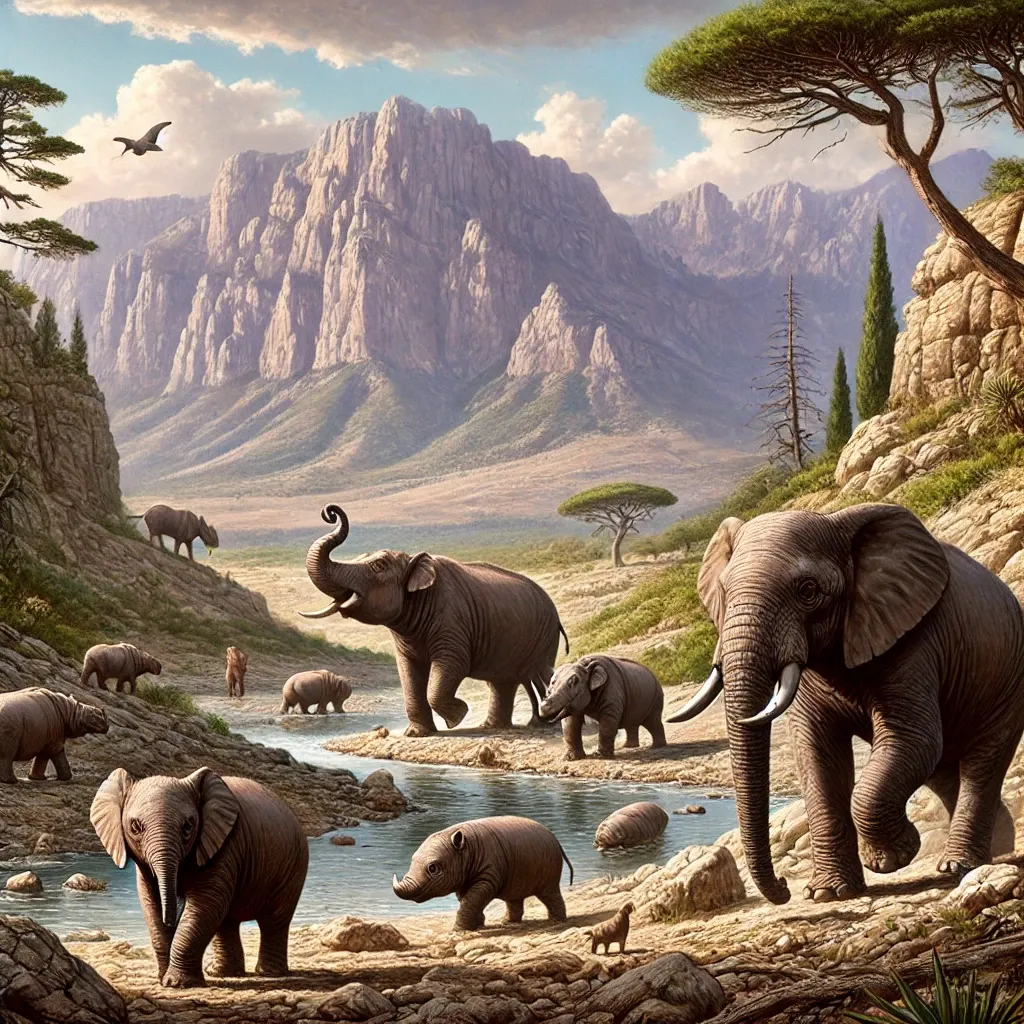









No comments :
Post a Comment
Obscene, threatening or obnoxious messages, preaching, abuse and spam will be removed, as will anything by known Internet trolls and stalkers, by known sock-puppet accounts and anything not connected with the post,
A claim made without evidence can be dismissed without evidence. Remember: your opinion is not an established fact unless corroborated.